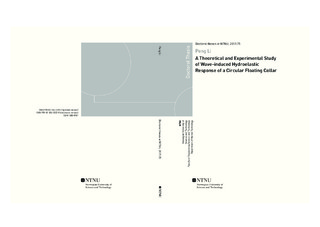| dc.contributor.advisor | Faltinsen, Odd Magnus | |
| dc.contributor.author | Li, Peng | |
| dc.date.accessioned | 2017-04-04T07:48:47Z | |
| dc.date.available | 2017-04-04T07:48:47Z | |
| dc.date.issued | 2017 | |
| dc.identifier.isbn | 978-82-326-2223-8 | |
| dc.identifier.issn | 1503-8181 | |
| dc.identifier.uri | http://hdl.handle.net/11250/2436667 | |
| dc.description.abstract | Wave-induced hydroelastic response of a circular plastic collar used as a floater of a net cage in aquaculture is studied by means of theory, model tests and numerical simulations.
A low-frequency linear slender-body theory for vertical radiation loads on an elastic semi-submerged torus based on matched asymptotic expansions is developed. Low frequency means that the corresponding wavelength is long relative to the cross-sectional radius. Linear vertical excitation load is calculated by either solving the diffraction problem with a cross-sectional averaged vertical incident wave velocity along the torus or by using a generalized Haskind relation. A curved beam equation with tension effects is used to predict the vertical wave-induced response of a semi-submerged torus in the frequency domain. The theory is verified by comparing with WAMIT. The analysis shows that three-dimensional flow, strong hydrodynamic frequency dependency and hydroelasticity are essential for the considered vertical wave loads and responses of the torus.
Model tests of both an elastic and a nearly rigid torus were performed in regular waves of different wave periods and steepness in order to validate the low-frequency slender-body theory. The bending stiffness of the elastic model was Froude scaled. Vertical accelerations along the torus, mooring line forces and the free-surface elevation at four positions in the wave tank were measured. Overtopping and out of water of parts of the torus models occurred in steep waves. Experimental precision errors and bias errors, for instance, due to tank-wall interference are discussed.
There is reasonable agreement between experiments and theoretically/numerically predicted linear response. The agreement between numerical methods and experiments is generally unsatisfactory for the nonlinear response. The two sets of experimental results show that the second, third and fourth harmonic vertical accelerations of the torus matter and cannot be explained by a perturbation method with the wave steepness as a small parameter. | nb_NO |
| dc.language.iso | eng | nb_NO |
| dc.publisher | NTNU | nb_NO |
| dc.relation.ispartofseries | Doctoral theses at NTNU;2017:75 | |
| dc.title | A Theoretical and Experimental Study of Wave-induced Hydroelastic Response of a Circular Floating Collar | nb_NO |
| dc.type | Doctoral thesis | nb_NO |
| dc.subject.nsi | VDP::Technology: 500::Marine technology: 580 | nb_NO |
